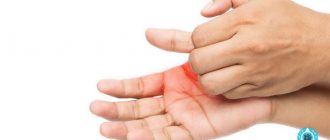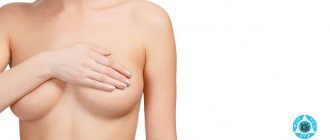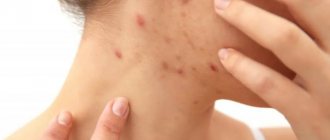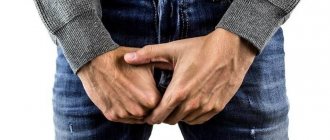Sometimes a person’s palms itch, and the causes of this symptom may be skin diseases, allergies, vitamin deficiencies and a number of external factors that can lead to itching. Itching may be accompanied by other symptoms that can more accurately identify the underlying problem. If your palms itch constantly, then you simply need to identify the main reason for this.
Itching on the palms of the hands and redness. Palms are red and itchy: causes of pathology
Here are the main groups of reasons that can cause itching and redness on the hands:
- Allergy. If a person is prone to allergies, it is not difficult to suspect it - taking a new medicine, consuming an allergenic product, or even a new soap can trigger an exacerbation. If a person has not previously suffered from allergies, it can be difficult to determine the nature of the rash. Solution: take a modern antihistamine - against its background, the rash and itching should sharply subside. Next, try to identify the allergen by gradually eliminating them one by one. It is long and laborious, but effective. If the problem cannot be solved, contact an allergist.
- Diseases of internal organs. It is the skin that is an indicator of the processes that occur inside the body. If your palms are itchy and red, this may indicate problems with internal organs - the liver, kidneys or pancreas. You can detect the connection like this: spots can disappear and appear again; In addition to the arms, the back, legs or any other parts of the body may be affected. The often described symptoms appear with diabetes mellitus - the skin flakes, dries, cracks. Solution: having ruled out dermatological causes and allergies, begin a comprehensive examination of the internal organs if problems with them already exist.
- Sunburn. People sensitive to the sun should take maximum care of their face and hands, since the skin here is most vulnerable. If itching, burning, dryness and spots appear after being in the open sun, this indicates a burn. Solution: With normal care, the problem will go away on its own in just a few days.
Associated symptoms
Itching that bothers a person for a long time indicates serious problems. You should also consult a doctor if you notice additional symptoms:
- Redness of the epidermis.
- Peeling (appears in the presence of a fungal infection).
- Formation of bubbles filled with liquid. They appear on the skin with eczema.
- Minor rash. This symptom is typical for scabies, dermatitis or allergies.
- Microcracks.
- Dry skin (mainly caused by the use of household chemicals, washing powders and cosmetics).
- Severe burning sensation.
Children are most susceptible to unpleasant symptoms. Poor nutrition, polluted air and water have a negative impact on their skin. If your child’s palm itches and rashes appear on the skin, immediately consult a dermatologist. The sooner you start treatment, the less harm will be done to the body.
The child's palms itch. Why does a child's palms or feet itch?
The resulting discomfort prevents children from sleeping and staying awake. To eliminate itching of the feet and palms, it is necessary to determine the cause. These can be both everyday factors and serious pathologies of various types.
Enterovirus infection
The skin disease is characterized by redness in different parts of the body. The lesion is primarily noticeable on the upper torso and arms. Hyperemia does not protrude above the surface. Sometimes the palms and feet become covered with small blisters, which burst within a week, leaving pigment spots. Over time, the symptoms disappear without a trace.
Allergic diseases
Rashes in a baby, accompanied by severe itching, may be the result of contact with an allergen. This clinical picture is caused by various factors:
- Food. An allergy to any food is possible. First of all, you need to analyze changes in the diet, exclude new foods and observe the reaction. An allergy may also arise from an oversaturation of certain components of dishes that were constantly present on the baby’s menu and were well accepted by the body.
- Medicines. When taking medications, a child’s palms often itch, turn red, and become covered with blisters. You must inform your doctor about this so that he can prescribe a different course of treatment or adjust the therapy by selecting an additional antihistamine.
- External stimuli. In summer, a rash and itching on the palms may occur when picking berries and flowers. Baby's feet become red and itchy after walking on hot sand at the beach or barefoot on the grass. In winter, discomfort remains for several days after the hands or feet are frozen. A common irritant is household chemicals. A child’s feet itch severely if socks or tights are not rinsed well. The discomfort is more noticeable if your feet are sweaty.
- Disturbances in the operation of internal systems. Atopic dermatitis manifests itself as severe itching for no apparent reason. This may be a decrease in immunity, or the occurrence of diseases in a latent form.
When you need to urgently seek help
In some cases, itchy palms can be a symptom of deadly Itching Without Rush conditions.
Call an ambulance immediately if, in addition to your hands itching, you notice:
- Difficulty breathing. This combination may indicate a serious allergic reaction - developing anaphylactic shock.
- Yellow tint to the skin or whites of the eyes. This indicates an obvious malfunction of the liver.
You don’t have to call an ambulance, but it is advisable to visit a therapist as soon as possible if, in addition to regular itching, you experience:
- Seemingly unreasonable weight loss. This combination of symptoms can accompany certain types of cancer - especially Hodgkin's disease.
- Enlarged lymph nodes that last for several weeks or more. Here the reason may be the same as in the paragraph above.
- Too rare urge to urinate - less than Urinary Frequency four times a day. This combination is a possible sign of developing kidney failure.
However, the situations listed above are still rare. Much more often, itching is caused by relatively harmless things.
Itching in the palms and soles. Itchy palms and feet: the main reasons
The palms and soles of the feet itch, the reasons for this phenomenon need to be found, otherwise the situation cannot be corrected - this is exactly what dermatologists say. You should be aware that if your palms and soles are scratched, the reasons for this are some kind of internal disease.
Itchy skin is not an independent disease - in any case, it will be a symptom of some primary pathology.
In terms of establishing the prerequisites for the appearance of this manifestation of the disease, a certain localization of feelings is fundamental. In the event that you immediately begin to feel itching in the area of the palms and feet, then first of all you will need to think about those nosologies that are listed below.
Problems of the hepatobiliary system (liver and gallbladder diseases) - cholestatic itching
These diseases are the most common cause of itching in the palms and soles of the feet (by the way, even if there is itching throughout the body, it begins specifically from these anatomical areas).
The mechanism of the phenomenon under consideration is the following - due to the fact that there is a violation of the excretion of bile from the common bile duct or some other problem, one way or another intertwined with an increase in the level of metabolites of this biological substance in the blood, irritation of nerve receptors is observed.
The root cause of these disorders can be a variety of pathologies:
- Hepatitis of all types - both infectious and non-infectious.
The palms and soles of the feet are scratched almost as intensely; - Intoxication (can be caused by medicinal products, pesticides, alcohol);
- Fatty hepatosis during pregnancy;
- Cirrhosis;
- Oncological neoplasms.
It is important to note that this kind of symptomatology occurs quite often in pregnant women, and not only with such a severe pathology as fatty hepatosis. The hormonal background, which undergoes more pronounced changes in the 3rd trimester of pregnancy, leads to disruption of the excretion of bile acids from the blood of the mother and fetus.
This particular mechanism is a more common prerequisite for the development of itching in these anatomical areas. So if a pregnant woman scratches her palms and soles, the reason for this, in most cases, will be a normal physiological process.
Diagnosis of an unpleasant illness
To identify the main cause of peeling and itching , the doctor must perform a visual examination of the patient’s palms. Orally, he should inquire about how long ago the symptom appeared and study its severity. If serious illness is suspected, urine and blood tests may be ordered.
If the main cause is considered to be a skin pathology, then it is necessary to submit material to confirm the diagnosis. Most often, a smear is taken as a material from areas of inflammation on the palm.
How to soothe itchy hands. 1 Selecting a remedy for immediate itching relief
- 1
Take a cold shower or bath. Scientists are still not sure about the specific mechanisms behind the formation of itching, but there is an assumption that itching occurs when faced with a certain “irritant” (for example, scratching). Cold water can be used to relieve itchy skin.
- Take a cold bath or shower. You can take advantage of the cooling benefits of taking a cold shower while pointing the watering can at the itchy areas of your skin. If you prefer baths, lie in a bathtub filled with cool water and soak for a while.
- Add essential oils to the water to help soothe your skin and stop irritation. Place 2-3 drops of essential oil into a bath of cool water. Chamomile has a calming and anti-inflammatory effect.
- Frankincense can soothe inflamed skin.
- Lavender helps relieve stress and reduce itching.
- Calendula oil can reduce itching by moisturizing the skin.
2
Apply a cold compress. Soak a towel or washcloth in cold water and then apply it to the itchy area of skin until the skin calms down. Try holding the compress for about 30 minutes. Calming occurs due to the fact that a wet cloth “soaks” (softens) the irritated skin and helps to “clean” it (remove dead skin cells).
- Instead, you can apply an ice pack or frozen processed foods to the itchy area, but they must be wrapped in a towel before applying to the skin. Apply frozen objects to your skin for about 10 to 20 minutes, but no more.
- Hot water and hot compresses increase skin irritation.
3
Soak the irritated area in a baking soda solution. Baking soda is a natural antipruritic that can be used for all types of itchy skin, but it is especially effective against itchy skin caused by bee and other insect stings.
- Add 1 cup of baking soda to cool bath water. Lie down in it for about 30–60 minutes.
4
Take an oatmeal bath or make an oatmeal paste. Oatmeal contains antioxidants that help soothe the skin and stop irritation. Colloidal oats are recommended, but when these are not available, whole oats or whole oat flour can also be used. You can use a coffee grinder to grind oats and cereal. The largest amount of active substances (anthranilic acid amines) is observed in unprocessed oats.
- Add 2 cups of raw oatmeal or oatmeal to your bath water. Remember that the water should be cool or lukewarm, but not hot, as this can harm your skin. Soak in the bath for an hour every day until the itching stops.
- Raw, uncooked oat flour can also be mixed with water to form a thick paste. The paste can be applied to the itchy skin for about 20-30 minutes.
5
Use aloe. Aloe vera has antifungal, antibacterial and anti-inflammatory properties. It is also very rich in vitamin E, which is useful in treating burns and helps reduce inflammation and itching.
- It is ideal to use fresh aloe juice! If you have aloe growing at home, take a leaf, cut it in half and then apply the gel-like contents of the leaf to the itchy area. Allow the juice to absorb into the skin and soothe it. Otherwise, you can purchase aloe vera gel from a pharmacy. Look only for 100% natural aloe vera gel.
- Do not apply aloe vera gel to open wounds or irritated or red skin.
6
Use fresh mint. A study has shown that taking a bath with fresh mint leaves and peppermint essential oil has a positive effect on itchy skin. Peppermint contains anti-inflammatory and anesthetic components that help reduce and stop itchy skin.
- Mint leaves steeped in hot water are even more effective as they release essential oils. Make sure to cool the infusion before applying it to your skin using a cloth soaked in it.
- Peppermint essential oil can be applied directly to the itchy area using a cotton swab.
Treatment with medications
The prescription of medications will directly depend on the reason why your palms itch. In general, a specialist may prescribe antiseptic, anti-inflammatory or antihistamine drugs to the patient. They can be presented in the form of medicines for internal use, as well as in the form of various ointments and creams for external use. However, some of them can only be sold with a doctor's prescription. Particularly effective external agents are:
- Elokom.
- Bepanten.
- Fenistil.
- Lokoid.
- Advantan.
- Radevit.
- Ketoconazole.
- Nizoral.
Palms and between fingers itch. Treatment with traditional methods
There are many traditional medicine recipes that can reduce itching or get rid of it completely. These techniques cannot replace drug therapy, as they do not affect the cause of the problem.
Your palms will itch less if you take warm baths daily. You can add decoctions of chamomile, string, celandine or oak bark to the water. Baking soda solution also relieves itching.
By using medications prescribed by your doctor, you can eliminate the itching fairly quickly. To prevent relapses, you should limit contact with household chemicals, wash your hands more often with fragrance-free soap, and minimize emotional distress.
Why do my palms itch? The reasons can be very varied. Sometimes this has no medical explanation, but in some cases it may indicate serious illness. The information provided below will help you understand this issue.
This phenomenon occurs in people of all ages and even small children. Considering the age category, working and living conditions, you can understand why your palms itch.
Rubromycosis
A well-known fungal disease. It mainly affects the palms, fingernails, toenails, and feet. Very rarely it appears on the stomach, buttocks, and back. This disease can be recognized by the following symptoms: the skin of the palms becomes thickened, up to the appearance of calluses. Over time, painful cracks form in them.
If this fungus infects the nails, then yellowish spots or stripes first appear in their plate. During development, the fungus occupies the entire nail.
People suffering from excessive sweating face this disease. As a preventive measure, it is recommended to follow the rules of personal hygiene, thoroughly dry the skin of the hands and palms (between the fingers).
Ascariasis
Roundworms are helminths that infect every third person in the world. Some people do not experience any changes in their health after being infected with these worms. But, in most cases, they cause a person many health problems.
Rashes on the palms of the hands are a sign of helminth infection in the body.
This is how the body reacts to foreign metabolic products. Moreover, roundworms release reproductive agents into the body, which are very toxic. If the palms of your hands itch, the reasons may be hidden in infection of the body with helminths.
Migrating helminths
This is a very unpleasant type of helminth that is found in the human body. Migrating worms live in the epidermis. They can move throughout the human body. Infection occurs due to the bite of insects, most often mosquitoes. The bite site begins to increase in diameter and turn red. There may be slight swelling.
After this, it is necessary to undergo a course of treatment using complex medications.
Preventive measures
The main rule to prevent itching is to wash your hands. Skin pathogens are transmitted through dirty handrails on public transport or during handshakes. If you do not have the opportunity to wash your hands regularly, then carry a sanitizer with you.
It is also necessary to carefully monitor the appearance and condition of the skin of your hands, especially in the cold season. Moisturize your skin twice a day and don't forget to wear gloves in the cold.
These simple recommendations will help prevent itching on your hands.









